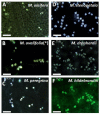Monitoring Indian "Superfood" Moringa oleifera Lam. - species-specific PCR-fingerprint-based authentication for more consumer safety
- PMID: 38615055
- PMCID: PMC11016095
- DOI: 10.1038/s41538-024-00264-z
Monitoring Indian "Superfood" Moringa oleifera Lam. - species-specific PCR-fingerprint-based authentication for more consumer safety
Abstract
Moringa oleifera Lam. has become one of the major new superfoods commonly available in the aisles of bio-shops and health-food sections in supermarkets of North America and Europe. While most of these products appear under the generic and scientifically inconclusive term "Moringa", the European Union, so far, has allowed commercialisation for the use in food and feed for M. oleifera only. M. oleifera is indigenous to India and South Asia, but large-scale cultivation of this species has spread to the tropical regions on all continents, with a strong focus on Africa, leading to a high risk of admixture with species like M. stenopetala (Baker f.) Cufod. that is native to Africa. In the present study, we have characterised six species of Moringa in order to develop a simple and robust authentication method for commercial products. While the plants can be discriminated based on the pinnation of the leaves, this does not work for processed samples. As alternative, we use the plastidic markers psbA-trnH igs and ycf1b to discern different species of Moringa and develop a diagnostic duplex-PCR that clearly differentiates M. oleifera from other Moringa species. This DNA-based diagnostic assay that does not rely on sequencing was validated with commercial products of "Moringa" (including teas, powders, or capsules). Our method provides a robust assay to detect adulterations, which are economically profitable for costly superfood products such as "Moringa".
© 2024. The Author(s).
Conflict of interest statement
The authors declare no competing interests.
Figures





Similar articles
-
Modelling habitat suitability for Moringa oleifera and Moringa stenopetala under current and future climate change scenarios.Sci Rep. 2023 Nov 18;13(1):20221. doi: 10.1038/s41598-023-47535-5. Sci Rep. 2023. PMID: 37980365 Free PMC article.
-
In vitro fermentation characteristics and effective utilisable crude protein in leaves and green pods of Moringa stenopetala and Moringa oleifera cultivated at low and mid-altitudes.J Anim Physiol Anim Nutr (Berl). 2013 Jun;97(3):537-46. doi: 10.1111/j.1439-0396.2012.01294.x. Epub 2012 Apr 12. J Anim Physiol Anim Nutr (Berl). 2013. PMID: 22497540
-
Profiling glucosinolates and phenolics in vegetative and reproductive tissues of the multi-purpose trees Moringa oleifera L. (horseradish tree) and Moringa stenopetala L.J Agric Food Chem. 2003 Jun 4;51(12):3546-53. doi: 10.1021/jf0211480. J Agric Food Chem. 2003. PMID: 12769522
-
Multi-functional application of Moringa oleifera Lam. in nutrition and animal food products: A review.Food Res Int. 2018 Apr;106:317-334. doi: 10.1016/j.foodres.2017.12.079. Epub 2018 Jan 4. Food Res Int. 2018. PMID: 29579932 Review.
-
Complementary Feeding Practices and Childhood Malnutrition in South Africa: The Potential of Moringa Oleifera Leaf Powder as a Fortificant: A Narrative Review.Nutrients. 2023 Apr 21;15(8):2011. doi: 10.3390/nu15082011. Nutrients. 2023. PMID: 37111230 Free PMC article. Review.
References
-
- Loyer J. Communicating superfoods: A case study of Maca packaging. Food Commun. Proc. Oxf. Symp. Food Cook. 2016;2015:236–246.
-
- Butterworth M, Davis G, Bishop K, Reyna L, Rhodes A. What is a superfood anyway? six key ingredients for making a food “super”. Gastronomica. 2020;20:46–58. doi: 10.1525/gfc.2020.20.1.46. - DOI
-
- Seyidoglu N, Inan S, Aydin C. A prominent superfood: Spirulina platensis. Superfood Funct. food- Dev. Superfoods Their Roles Med. Biol. 2017;22:1–27.
-
- Schiemer, C., Halloran, A., Jespersen, K. & Kaukua, P. Marketing insects: Superfood or solution-food? Edible Insects Sustain. Food Syst. 213-236 (2018).
-
- Mintel. Available at: http://de.mintel.com/pressestelle/deutschland-der-weltweit-zweit-innovat... - last accessed 13.12.2023 (2018)
LinkOut - more resources
Full Text Sources
Research Materials

